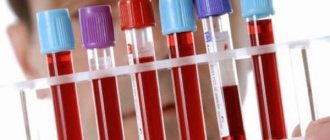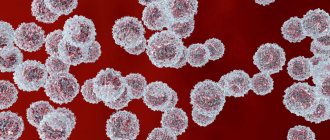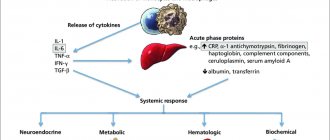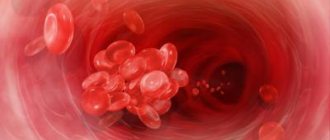Method for determining fibrinogen
A test for blood clotting is called a hemostasiogram or coagulogram.
It determines fibrinogen and other quite important indicators of hemostasis. More often, venous blood is used for this purpose. In order for the test result to be as accurate as possible, the patient needs:
- It is imperative to plan to donate blood on an empty stomach (last meal no later than 12 hours before the test).
- Eliminate stress and physical activity several hours before the planned test.
The laboratory technician draws blood with a syringe and places it in a test tube, the walls of which have been pre-treated with a solution of citric acid salt. This is done to prevent the clot from coagulating. Next, the plasma (its liquid part) must be removed from the obtained blood - it is in it that fibrinogen is examined. In laboratories, fibrinogen is determined by different methods:
- immunochemical;
- color (colorimetric);
- optical;
- by weight.
If the pregnancy proceeds normally, then during its entire period a blood clotting test is carried out three times. The first examination is performed when the expectant mother is registered, but this period should not exceed 12 weeks of pregnancy. This is a reference point that influences the frequency of future inspections. If the results are normal, the coagulogram is next performed at 25–26 weeks of pregnancy.
What it is
Fibrinogen is a protein produced by the liver. It precedes the synthesis of fibrin, a substance that forms a clot during blood clotting.
The importance of this indicator is that deviations from the normal level can cause both fetal growth retardation and problems in the maternal body. There is a lot of blood loss during childbirth, and this important protein helps prevent heavy bleeding.
That is why a woman is prescribed a coagulogram and, if necessary, a hemostasiogram, with the help of which other serum parameters are determined
There is a lot of blood loss during childbirth, and this important protein helps prevent heavy bleeding. That is why a woman is prescribed a coagulogram and, if necessary, a hemostasiogram, with the help of which other serum parameters are determined.
The effect of fibrinogen on pregnancy
Elevated fibrinogen levels during pregnancy are common. This is how the body prepares for future childbirth, because some blood loss is inevitable.
How does fibrinogen affect pregnancy:
- The increased amount is due to future blood loss of up to 500 ml - this is how the body protects itself from the development of pathologies. After childbirth, the indicators return to normal.
- Due to an increase in this protein, the fetus may experience oxygen starvation, placental abruption ahead of schedule, and death is possible. Blood clots that appear due to fibrinogen during pregnancy are able to move into the vascular system of the placenta, forming an insufficient blood supply.
- A high concentration can cause pathologies in the mother’s body, leading to thromboembolism of the arteries of the lungs (risk of death due to the impossibility of oxygen and carbon dioxide exchange).
- Decreased or hypofibrinogenemia causes bleeding, which can form in any of the organs of a pregnant woman. Bleeding in the uterus leads to possible termination of pregnancy.
What is the function of fibrinogen and how to determine its level
Fibrinogen is a protein produced by hepatocytes. It stimulates the production of hormones, bile acids, insulin and progesterone. During pregnancy, this blood clotting factor is considered one of the most important indicators of the hemostasiogram.
Doctors monitor the content of the indicator throughout pregnancy, as it shows the degree of thrombus formation, which is especially important during childbirth. Blood clots reduce blood loss when the baby leaves the womb
At the same time, fibrinolysis during gestation is slowed down.
The fibrinogen content is determined using a hemostasiogram three times during the entire period of pregnancy (in the first, second and third trimesters), unless there are special indications that require a coagulogram more often.
To make the test more informative and help the doctor prevent possible complications, follow the necessary conditions:
- Donate blood in the morning on an empty stomach. You cannot take the test after eating, and you cannot drink juices, tea or coffee an hour before the test. On the eve of the hemostasiogram, it is advisable to have a light dinner, excluding fatty foods 2 days before the test.
- Before a coagulogram, try not to do strenuous work or put stress on the body. Try to get a good night's sleep.
- If you are taking anticoagulants, you should warn your specialist about this.
- 1-2 hours before the test, drink 1 glass of clean water.
To determine the indicator, the pregnant woman comes to the treatment room, where venous blood is drawn. The specialist tightens the forearm with a tourniquet, after which, at the elbow bend, he inserts a needle into a vein, drawing blood into special tubes. After the procedure, the expectant mother squeezes the injection area, and the nurse turns the container with the material over several times to prevent the formation of blood clots in it.
How to maintain the norm
To ensure that the patient does not encounter problems with increased fibrinogen protein during pregnancy, it is recommended to carry out preventive measures. For example, it is recommended to plan conception, and in preparation for such an important event, the patient needs to undergo a hemostasiogram to determine the concentration of all blood factors and its other components. It is also necessary to adjust the diet, limiting the consumption of foods that increase fibrinogen and have a blood-thinning effect (leafy green vegetables or cauliflower, etc.).
You need to follow the recommendations for drinking regime, especially in the summer season. Also, mommy needs to promptly take laboratory tests prescribed by the doctor, regularly visit the gynecologist, and follow his instructions. Bad habits during pregnancy are unacceptable, so they will have to be excluded, as well as depressive, stressful conditions, excessive worries and other psycho-emotional stress. It is better for mothers to spend as much time as possible in the fresh air.
After conception, girls’ bodies, through hemostatic structures, prepare to prevent heavy blood loss during childbirth. During this important period, there is a natural increase in blood clotting factors, and fibrinolytic activity decreases. Blood clots much faster, but if fibrinogen levels are too high in a pregnant woman, the risk of thrombosis increases. Therefore, it is necessary to take the prescribed tests in a timely manner to prevent dangerous complications.
How to respond to increased indicators
Most often, the reasons for this phenomenon are:
- ARVI;
- flu;
- viral or infectious diseases;
- pneumonia;
- strokes;
- pathologies of the cardiovascular system.
Such changes can be corrected by following a special diet. The following products should predominate in it: chocolate and raspberries, pomegranate and beets, decoctions of clover and peony inflorescences.
If you ignore the test result and do not seek medical help if the readings are high, then a threat directly to the woman’s body develops. There is a high probability of placental abruption, which will lead to premature birth or miscarriage. In the future, such pathologies lead to the development of infertility.
To normalize fibrinogen levels, doctors also use drug therapy.
- Folic acid;
- vitamin complexes;
All of them help thin the blood and prevent the formation of blood clots.
A pregnant woman should not perceive any deviations from the fibrinogen norm as a death sentence. Modern medicine has a sufficient level of knowledge and techniques that make it possible to help every patient bear and give birth to a healthy baby. In addition, timely diagnosis and regular visits to the gynecologist will help avoid pathology with fibrinogen in the 3rd trimester.
Since pregnancy is always stressful for a woman’s body, the circulatory system is the first to react. It is rebuilt, changes occur in the composition of the blood that are necessary for the development of the fetus.
If the doctor is unable to stabilize fibrinogen levels before birth, the woman is placed in a specialized perinatal center, where experienced obstetricians work and all the necessary equipment is assembled to help mother and baby.
Having decided to give birth to a child, every woman should know that not only her health, but also that of the child depends on her responsibility and understanding of each study. All tests and diagnostics offered by a gynecologist must be completed with an understanding of their essence and the ability to decipher their meanings. Fibrinogen is an important indicator that will allow a woman to bear a healthy baby and give birth on time without any pathologies or bleeding.
What if the level is low: key factor and possible complications
Of all the possible reasons for a decrease in protein concentration in the blood, this most often happens due to severe toxicosis.
As a result, the following negative reactions may occur:
- premature difficult birth;
- placental abruption;
- decreased uterine tone;
- embolism;
- high blood pressure.
Fortunately, medical practice provides measures to restore the level of the blood serum component.
Fibrinogen during pregnancy
Pregnancy is not such a serene time as many people think. A woman “in an interesting situation” has to take numerous tests and undergo various examinations in order to eliminate the risk of pathological development of the fetus
This is very important, because any expectant mother sincerely wants to give birth to a healthy and strong baby
A biochemical blood test is a unique opportunity to timely predict pathologies in the pregnant body
A blood test is one of the first indicators of the health of the mother and child; a biochemical blood test is a unique opportunity to promptly anticipate pathologies in the body and, accordingly, eliminate them immediately. Delay in this matter can cost your life.
Important blood indicator
Fibrinogen during pregnancy is a protein in the blood that gives a clear idea of the performance of the hematopoietic system in the body of the expectant mother, that is, it determines the real indicator of coagulation. It is produced in sufficient quantities by liver cells, penetrates into the general bloodstream and, under the influence of thrombin, is reformed into fibrin. Fibrin is a non-globular protein that helps form blood clots that prevent large blood loss during labor.
That is why it is so important that this indicator has the characteristic “norm”, especially since its high or low indicator eloquently indicates the presence of pathology
Normal in blood
According to doctors, the norm of fibrinogen for non-pregnant women varies between 2-4 g per 1 liter of blood. If we talk about expectant mothers, then this indicator is increased and corresponds to 6 g for the same amount of blood. The increase in protein concentration in the blood is gradual and begins only at 3 months; but this does not mean at all that a pathological process is taking place. This is explained by the fact that during pregnancy an increased amount of blood flows in a woman’s body due to the formation of the uteroplacental circulation. To determine fibrinogen during pregnancy, the doctor refers the patient to a coagulogram. The procedure is classic: the required amount of blood for further laboratory testing is taken from a vein, preferably on an empty stomach
It is very important not to be nervous and not to smoke, although these bad habits should not exist in a woman’s daily life. It is recommended to donate blood for analysis in all trimesters of pregnancy, and the normal value will be different each time
- first trimester of pregnancy – 2.3 – 5 g;
- second – 2.4 – 5.1 g;
- third – 3.7 – 6.2 g.
If the result obtained does not fall within the established limits, a full examination is required to determine the root cause of the pathology and effective conservative treatment as indicated.
Deviations from the norm
As practice has shown for many years, fibrinogen during pregnancy can be increased or decreased. But what explains such anomalies? The causes of low fibrinogen are:
- severe toxicosis in the second half of pregnancy;
- acute deficiency of vitamins C and B12 in the body;
- DIC syndrome;
- extensive liver damage (hepatitis, cirrhosis);
- blood disease;
- poor nutrition;
- weakened immunity.
The causes of high fibrinogen are as follows:
- inflammatory and infectious diseases (flu, meningitis);
- tissue death (stroke, myocardial infarction);
- malignant tumors;
- burns of various degrees;
- hormonal imbalance of the body.
If a woman does not yet know about her “interesting situation,” then the fibrinogen indicator will declassify the presence of pregnancy. In this case, it will be increased, and the doctor, after the results are ready, will tell the good news.
An increase in fibrinogen during pregnancy above the normal level can lead to extremely negative consequences.
Possible complications
If the above-mentioned protein in the blood predominates in excess, this can lead to irreversible consequences for the health of the mother and fetus, in particular:
- spontaneous miscarriage at the very beginning of pregnancy;
- undeveloped or frozen pregnancy;
- thrombosis of umbilical cord vessels;
- premature birth.
To avoid such consequences, doctors strongly recommend undergoing a full clinical examination when planning pregnancy, and, if necessary, treatment in advance.
Consequences of pathology
If fibrinogen increases during pregnancy, the rate of which depends on the period, then this can lead to a variety of undesirable consequences
. In this case, the woman’s well-being worsens, and pathologies in the child’s development may also be observed. High levels of protein can lead to thrombophlebitis and thrombosis.
Important!
If fibrinogen is elevated during pregnancy in the first trimester, which determines the formation of the fetus, or at a later date, this can lead to serious complications. That is why timely treatment of the pathology is recommended.
If the indicator increases in the early stages, then the woman may be diagnosed with placental abruption. Against this background, the pregnancy spontaneously terminates, and the fetus freezes. When a pathological process appears in the later stages, premature birth occurs. The pathological process often leads to the formation of gestosis. With an increase in the amount of protein, the umbilical cord vessels can become clogged with blood clots, which leads to a fatal outcome for the fetus.
Therapy for deviations from the norm
An increase in fibrinogen is a reason for another examination and consultation with a hematologist.
A specialized specialist decides on therapy that normalizes protein levels. Commonly used medications include B vitamins, Aspirin and Curantil. The drugs are prescribed by a doctor. Increased clotting is corrected by including beets, pomegranate, seafood, strawberries, grapefruit, and cranberry juice in the menu. If antiphospholipid antibodies, hereditary diseases or a high level of D-dimers are detected, the woman is registered with a hematologist. When fibrinogen is reduced, the causes of the deviation are identified, drugs are prescribed to help normalize the indicator, and diet. With late toxicosis and DIC in the last weeks before birth, hospitalization is required to monitor the condition.
Increased fibrinogen
Deviation from the established norm in the direction of increasing fibrinogen is called hyperfibrinogenemia. It is diagnosed when the indicators diverge from the norm by 1 gram or more.
Of course, only a doctor can tell whether a pregnant woman needs treatment for hyperfibrinogenemia or not.
The reasons for the increase in fibrinogen can be quite serious factors, namely:
- development of inflammatory processes;
- infection by bacteria, viruses or fungi;
- necrosis (death) of tissues;
- congenital blood diseases.
Abnormally high levels of fibrinogen during pregnancy can lead to quite unpleasant consequences.
First of all, with excessive blood viscosity, there is a high risk of blood clot formation. A blood clot can break away from the vessel wall and block a vital vein or artery, resulting in coma, death of the woman, or loss of the fetus.
Secondly, too thick blood is not able to supply the placenta with sufficient oxygen.
Due to oxygen deficiency, hypoxia, death or premature aging of the placenta can develop, which leads to premature birth of the fetus or its death.
A slight increase in fibrinogen can cause severe fatigue of the expectant mother, lethargy, dry skin and hair.
Treatment of hyperfibrinogenemia is carried out by a hematologist in the form of complex therapy. The doctor prescribes indirect anticoagulants (drugs that reduce clotting), low molecular weight heparins and a special diet.
The diet excludes the consumption of foods that thicken the blood. Such foods include cabbage, parsley, spinach, rose hips, bananas, rowan berries, and walnuts. They should be consumed in limited quantities or completely abandoned.
The menu should include foods that reduce blood viscosity and are rich in vitamin C:
- beet;
- seaweed;
- lemon;
- tomatoes and tomato juice;
- grapefruit;
- raspberries;
- cherry;
- currant;
- linseed oil.
Treatment of hyperfibrinogenemia should not be carried out independently and on your own initiative.
Only qualified specialists are able to carry out complex therapy that reduces the amount of fibrinogen without harm to the expectant mother and her baby.
What is fibrinogen, why is it needed in the body
When there is a threat of blood loss, the protection system is triggered - the blood begins to clot, preventing “leakage”. One of the main roles in this process is played by the colorless protein fibrinogen, which is synthesized in the liver and then dissolves in the blood plasma.
When the clotting mechanism is initiated, fibrinogen is converted to insoluble fibrin; it, in the form of the thinnest threads, binds blood cells, thus serving as the basis of a blood clot that clogs the damaged vessel. Then, under the influence of other substances, the blood clot dissolves.
It takes 10 minutes from the formation of the primary clot from adhered platelets (blood cells) to the addition of fibrinogen and the formation of a full-fledged fibrin thrombus.
Fibrinogen produces white strands of fibrin, which form a clot that stops bleeding
The level of fibrinogen in the bloodstream varies depending on the condition of the body and various types of diseases.
Fibrinogen and pregnancy
How the expectant mother’s blood clots depends on:
- nutrition and respiration of the fetus - and therefore growth and development;
- functions of a temporary organ - the placenta;
- woman's health, normal pregnancy.
At different stages of gestation, the amount of fibrinogen changes; nature seems to take into account the upcoming loss of blood during childbirth and, in order to reduce the severity of the problem, gradually increases the thickness of the liquid tissue (and therefore increases the amount of fibrinogen). Thick blood does not leave the body as quickly.
However, an excessive increase in plasma protein levels or, conversely, a decrease that does not fit into the norm is a sign of serious problems in organs and tissues. Therefore, in pregnant women, fibrinogen levels are checked at least three times - in each trimester.
Increased normal levels and its causes
Exceeding the norm of fibrinogen during pregnancy indicates that a woman has thick blood. The danger of this phenomenon is that blood clots may form in the vessels. This also applies to the vascular system of the placenta, which can lead to insufficient nutrition of the fetus and delayed development. The child may develop signs of hypoxia.
If fibrinogen is increased during pregnancy, most likely this happened as a result of:
- inflammatory processes caused by infections;
- decreased thyroid function;
- tissue necrosis;
- development of neoplasms;
- pneumonia;
- heart attack;
In some cases, an increased concentration of this indicator may be an individual characteristic of the organism.
and also be the result of long-term use of estrogen-based hormonal drugs before pregnancy. In some cases, exceeding the value is possible after operations. relatively recently suffered burns.
Sometimes an increase can be observed due to improper preparation for the study. As mentioned above, the level of clotting can be affected by stress and overexertion, fatty foods taken the day before, and improper water regime.
Reasons for the increase
It often happens that fibrinogen is increased during pregnancy in the first, most important, trimester and in later stages.
This pathological condition develops against the background of various diseases.
The most common causes of increased fibrinogen are infectious diseases
, in which an inflammatory process occurs in a woman’s body.
Interesting! Why are leukocytes elevated in a smear during pregnancy?
The appearance of pathologies is diagnosed after surgical interventions. An increase in the amount of protein is observed against the background of a heart attack or stroke.
If a woman’s body has a malignant tumor, this can also lead to the development of pathology. In post-burn conditions, the amount of this protein in the blood increases. The pathology is diagnosed during the period of taking certain medications, especially oral contraceptives. The condition can be observed when:
- tuberculosis;
- diabetes mellitus;
- hepatitis;
- thrombophilia.
If a woman has pathological processes in the thyroid gland
, then this also leads to an increase in fibrinogen. The causes of the pathology can be acute respiratory diseases or influenza. The occurrence of the disease can be observed with thrombophilia.
Important! What are the dangers of increased protein in urine during pregnancy?
Only a specialist knows why protein levels may increase. That is why a woman is recommended to undergo appropriate tests in a timely manner while carrying a child.
Why monitor fibrinogen during pregnancy?
All this can lead to a change in the rheological properties of blood (its “fluidity”) and also affects the rate of thrombus formation.
No doctor can predict how a pregnant woman’s body will react to the changes taking place. We can talk about the tendency of a particular patient to increase fibrinogen or, conversely, to thin the blood.
You can also rely on the presence of chronic diseases or the experience of previous pregnancies. But the real state of the blood is shown only by tests carried out in accordance with the pregnancy calendar. A woman must understand their necessity.
However, it is not at all necessary that every pregnant woman experiences a bleeding disorder. The analysis will show whether the data obtained is a variant of the norm, or whether additional monitoring and medication are required for the successful completion of pregnancy.
There is no separate test for fibrinogen, but all pregnant women undergo a coagulogram or hemostasiogram to monitor the state of the blood coagulation system. During this study, fibrinogen levels will also be determined.
After blood is taken, the liquid part, plasma, is separated from it in the laboratory, and it is this that is examined for fibrinogen content.
In the arsenal of modern doctors there are test systems for determining the amount of fibrinogen in various ways: optical, gravimetric, immunochemical, and a colorimetric (color) method is also possible.
The methods are based on the refraction of a light beam, characteristic of each type of molecules, their mass and types of interaction with chemical reagents. The results are accurate and allow us to reliably judge possible changes in blood quality.
Diet therapy
A large number of women think about how to reduce fibrinogen during pregnancy. If the deviations are minor, then treatment can be carried out with diet
. The patient is recommended to consume foods that improve blood clotting during pregnancy.
Important! What pregnant women should not eat: list of prohibited foods
Patients are recommended to eat buckwheat porridge and boiled potatoes. Green vegetables are quite useful in the treatment of pathological conditions. It is recommended to prepare salads using leafy vegetables. Correction of protein in the blood is carried out using cauliflower and white cabbage
. While carrying a child, a woman is recommended to eat eggs. A patient’s diet if the indicators are abnormal should consist of bananas and spinach. For drinks, you should give preference to herbal infusions.
Why fibrinogen in the blood increases and how to stabilize it, only the doctor who develops a diet for the patient knows, which guarantees its effectiveness.
General information
Fibrinogen is an important component of blood plasma. It is of protein origin, its structure is a glycoprotein and belongs to the class of globulins with a fairly large molecular weight. The synthesis of this protein occurs in the liver, from where it enters the blood, where it is normally found in an amount of 2–4 g/l. Its content is determined by a biochemical analysis of blood taken from a vein.
The fibrinogen level, like many biochemical indicators, is a constant and must be maintained within the specified limits. The normal course of the following processes depends on its concentration:
- Blood clotting.
- Inflammation.
- Vascular formation.
One of the most important functions of fibrinogen is to stop bleeding. It is a precursor of fibrin, the main factor in the formation of a blood clot. This indicator is also an acute phase protein of inflammation, which increases in many serious diseases.
Decreased fibrinogen levels
Pathological reasons can lead to a decrease in the amount of this protein in the blood of a pregnant woman:
- chronic diseases of the liver and kidneys, often aggravated during pregnancy;
- unbalanced diet with insufficient intake of protein and vitamins;
- diabetes;
- oncological diseases;
- immunodeficiency states.
A low concentration of coagulation protein in the blood of a pregnant woman leads to dangerous consequences. Possible complications: internal bleeding due to gastric ulcer, exacerbation of chronic colitis.
These diseases can lead to the development of serous-fibrinous peritonitis with perforation of a stomach or intestinal ulcer. In this case, serous fluid with a large amount of fibrin accumulates in the peritoneal cavity, which is prone to the formation of films. This condition requires immediate hospitalization. Emergency conditions include hemorrhagic stroke, hemorrhage into the ventricles of the brain.
The development of disseminated intravascular coagulation syndrome is very dangerous due to the imbalance of the hemostatic system. Premature placental abruption is possible. For the fetus, a decrease in fibrinogen in the blood can result in developmental defects, malnutrition and death.
Indications for fibrinogen testing
Fibrinogen is a protein produced by the liver that helps stop bleeding by creating clots. At the last stage of coagulation, it participates in the formation of a fibrin clot:
thrombin first breaks down fibrinopeptides;
residual fibrin monomer molecules begin to polymerize, forming a clot.
Protein is important in wound healing, fighting infections and in blood clot compression. Most often, fibrinogen is increased during pregnancy only because this is an adaptation of the body to protect the fetus. Normal protein levels are initially higher than in non-pregnant women. It can be lowered or overestimated relative to new indicators:
when elevated, it can affect thrombosis;
when decreased, it causes a risk of bleeding.
A healthy level for an adult woman is 2-4 g/l, but during pregnancy the norm changes. In the second trimester, fibrinogen doubles in pregnant women, which means the body is preparing for childbirth.
Typically, a test is prescribed if women have:
bleeding disorders;
bleeding in medical history;
miscarriages.
Fibrinogen is detected in the blood according to Claus: thrombin is added to diluted plasma and the rate of clot formation is assessed. The partial active thromboplastin time is used to evaluate protein. The norm ranges between 35-45 seconds. The analysis is not limited to two indicators. Prothrombin and thrombin time, D-dimer and overall coagulation rate are assessed. The level of fibrinogen during pregnancy depends on the duration of pregnancy:
| 1st trimester | 2.3-5 g per liter |
| 2nd trimester | about 5.1 g/l |
| in the 3rd trimester | 4.95-6.2 g/l |
Protein is higher than normal
An increase in fibrinogen during pregnancy is observed against the background of many diseases, such as influenza, pneumonia, ARVI and malignant tumors, rheumatic processes, pathology of the thyroid gland, hypothyroidism.
The following factors may influence the indicator: diabetes mellitus, hepatitis, tuberculosis. In fact, a deviation in protein allows one to suspect the presence of a problem in the body, the treatment of which is necessary. High fibrinogen during pregnancy creates threats to pregnancy, risks of miscarriages, gestosis, thrombosis of the umbilical cord arteries and pulmonary thromboembolism in the expectant mother.
The fertilized egg is implanted in the decidua of the uterus and a connection is established between the fetus, placenta and maternal circulation. This contact is important for the entire period of pregnancy. Sometimes thrombosis disrupts this process, which leads to early spontaneous miscarriage. The causes of miscarriage in the first trimester are often associated with thrombosis of the placental vessels. Therefore, determining fibrinogen during pregnancy by trimester will help counteract thrombosis associated with fetal abnormalities, miscarriage and obstetric complications.
Protein below normal
A decrease in clotting factor increases the risk of bleeding. Deficiency occurs for several reasons:
- lack of vitamin C and B12;
- gestosis;
- DIC syndrome;
- hepatitis.
The level of fibrinogen during pregnancy decreases due to burns, blood loss, intoxication, eclampsia or increased blood pressure in pregnant women.
Receiving a reduced rate of fibrinogen indicates the following conditions:
- disseminated intravascular coagulation syndrome (when the body uses too much protein);
- substance deficiency (congenital or acquired)
- fibrin breakdown (fibrinolysis)
- bleeding.
The test is performed if there is a risk of premature placental abruption.
Prolonged severe toxicosis with frequent bouts of vomiting provokes a lack of protein. If the indicator is less than 1 g/l, severe pathology should be suspected:
- amniotic fluid embolism;
- frozen pregnancy;
- placental abruption.
Hematologists often record excess levels of fibrinogen in the blood during pregnancy. The protein is a potential marker for arterial thrombosis and inflammatory processes. An increased rate is also associated with the risk of atherosclerosis and other vascular diseases. Low - observed against the background of acquired diseases, when its synthesis decreases or consumption increases greatly.
Fibrinogen: normal
- A gradual increase in fibrinogen levels occurs consistently from the third trimester and reaches maximum values immediately before childbirth. This time dependence is due to the formation of the child’s independent circulatory system. By week 40, the protein concentration reaches its peak in order to prevent the woman from losing a lot of blood during the birth of her baby.
- The normal level of fibrinogen in the first trimester of pregnancy is 2.98 g/l. This figure is slightly underestimated compared to the average level for a non-pregnant woman. This level is due to early toxicosis that accompanies the restructuring of the body.
- In the second trimester, the protein level begins to gradually increase and reaches 3.1 g/l.
- The last trimester is characterized by a sharp and rapid increase in fibrinogen levels and can reach from 4.95 to 6 g/l.
- Fibrinogen levels in the last weeks of pregnancy determine a woman’s readiness for childbirth.
- If the results of the hemostasiogram are very different from the norm, additional tests are prescribed, namely: studying the level of D-dimers, determining the rate of plasma coagulation, the presence of antibodies, their quantity and other indicators.
- If the deviations are insignificant, a repeat hemostasiogram and additional examination and tests are prescribed.
- To normalize the fibrinogen level, the expectant mother is prescribed B vitamins in large doses, folic acid, a small dose of aspirin and various types of antiplatelet agents.
- If the disturbances are significant, the pregnant woman must consult a hematologist. However, in this case, the gynecologist will give subsequent recommendations for monitoring pregnancy, taking into account the conclusion of the hematologist.
- A pregnant woman who has problems with blood clotting is required to give birth in a special department, where the pregnant woman’s condition is closely monitored by specialists.
Methods for normalizing indicators in a pregnant woman
If the fibrinogen level deviates from the norm, doctors act on one of two options. If its excess or decrease is insignificant, and most importantly, the reason for this deviation is known, the pregnant woman’s condition is monitored and dynamics are monitored. If the value is exceeded or reduced critically, drug therapy is carried out to stabilize it.
Pregnancy monitoring by a doctor increases the likelihood of an easy and safe birth
How to lower fibrinogen levels
If the value increases slightly after a coagulogram, the observing doctor may prescribe general medications that will help normalize the value. Such medications include:
- folic acid;
- B vitamins;
- blood thinning drugs.
An important point in the process of lowering fibrinogen levels is following a diet and adding foods to the diet that help thin the blood. These include:
- many fruits and berries;
- seafood and fish;
- citrus;
- buckwheat;
- legumes and walnuts.
Test deadlines
A blood test for fibrinogen is taken in the first week of each trimester of pregnancy.
If the concentration of fibrinogen levels during pregnancy decreases after the 6th month of gestation, this should alert the doctor. A low rate can be observed against the background of late toxicosis, when the woman’s condition sharply worsens and the fetus may die. A blood test is taken from a vein or finger, in the morning, before meals. The day before, it is better to avoid excessive physical activity, sudden changes in diet and stressful conditions.











